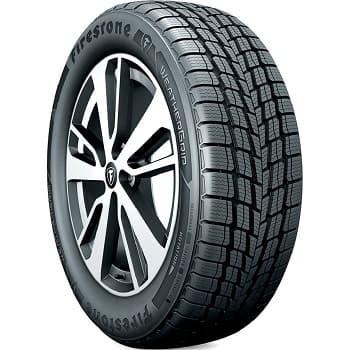
Pros
- Surefooted handling on snow and very easy to control when it loses traction
- Exceptional acceleration traction on packed and unpacked snow for an all-season tire
- Shortest braking distances on snow compared to any other all-season/all-weather tire
- Best-in-class traction and grip on ice
- Solid grip and traction on dry roads, especially for a tire with that many grooves and sipes
- Deals with most bumps without too much fuss
- Very solid treadlife and long treadwear warranty
Cons
- Noisier than most all-season tires due to the more aggressive tread pattern
- Harsh over big road imperfections
- The softer compound makes it less responsive on the street, especially in warm weather
North American drivers swear by all-season tires. And that’s quite understandable – all-season tires are cheap, provide safe year-round traction, and last longer than any other type.
Well, that’s mostly true, except for the fact that most all-season tires are only adequate on snow. Particularly, they work fine in a pinch over light snow but put them in a more serious situation, and they’ll start to underperform.
For that reason, many manufacturers have started launching “all-weather” tires lately. These are similar to all-season tires in a way that they offer year-round traction but are more focused on delivering higher snow and ice traction rather than razor-sharp handling on dry roads.
And with the WeatherGrip, Firestone wanted to create the ultimate all-season/all-weather tire – one that will work equally well on dry, wet, and snowy roads.
The tire even comes with the 3PMSF (Three-Peak Mountain Snowflake) symbol, which signifies higher-than-regular longitudinal traction on snow.
This is evident by the quite aggressive tread pattern, which includes a larger void area and multiple sipes across all blocks. In that sense, it resembles a winter tire more closely than an all-season one.
However, the experience taught me that looks could cheat, which begs the question – is the Firestone WeatherGrip any good?
I’ve tested the tire in various conditions and prepared an in-depth Firestone WeatherGrip review to help you find out if you should put it on your car. Enjoy!
Contents
What are the Specifications and Maintenance Indicators?
The Firestone WeatherGrip is a grand-touring all-season (all-weather) tire designed to fit most passenger cars, like hatchbacks, sedans, coupes, minivans, and even some crossovers.
It comes in multiple sizes, ranging from 15-inch to 19-inch wheel diameter. So, if you own a passenger car produced in the last two decades, you should be able to find a dimension that fits.
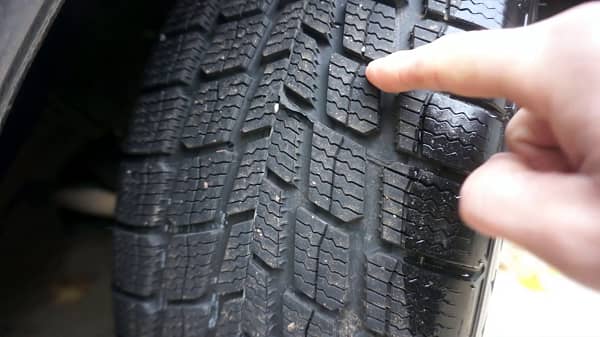
Like most manufacturers, Firestone utilized the industry-standard tread wear indicators (TWIs). These indicators are required by law since they tell you when you must change your tires.
The TWIs are narrow rubber bars that sit recessed into the grooves of the tire but protrude 2/32-inch from the surface. Hence, when the tread depth reaches 2/32-inch, they will be flush with the surface.
The reason why authorities chose 2/32-inch as the minimum tread depth is that it is considered that tires with less tread than that won’t provide safe hydroplaning resistance.
In other words, they won’t be safe for driving in wet conditions.
Okay, but what about snow and ice? That’s quite an interesting question and important for the Firestone WeatherGrip.
Namely, while tires with 2/32-inch will function reasonably well in rainy conditions, they won’t function at all on snow, where you’ll need at least 5/32-inch of tread depth left for safe traction and grip.
Unfortunately, Firestone hasn’t equipped the WeatherGrip with such indicators, but other tire makers don’t offer them, either (on all-season tires).
With that said, you won’t need to care about that soon, as the Firestone WeatherGrip comes with a 65,000-mile treadwear warranty. That’s slightly shorter than the best grand-touring all-season tires but still outstanding for an all-weather tire with winter credentials.
Case in point, the Michelin CrossClimate 2 is much more expensive yet comes with a 60,000-mile treadwear warranty.
Features and Performance of the Firestone Weathergrip
According to Firestone, the WeatherGrip lets you take control of the road whether the sun is shining, raining, or snowing.
To help you with that, the tire features an all-season tread compound and a fairly aggressive tread pattern with deep grooves and large sipes.
Let’s go through each feature and see if it made a difference in the real world!
1. Dry Grip and Traction
The WeatherGrip features a directional tread pattern, meaning it’s focused on delivering the highest possible longitudinal traction.
However, Firestone also equipped the tire with chamfered shoulder blocks, aiming to improve the cornering grip on dry roads and further enhance the braking.
Did it work, though? Well, the WeatherGrip is certainly no slouch on dry roads.
According to our dry road test, the longitudinal traction it provides is indeed good, meaning your vehicle will accelerate easily, and the stopping distances will be short.
I was also impressed with the cornering grip, particularly because the tire wasn’t designed with that in mind; any tire with that many sipes will struggle with cornering.
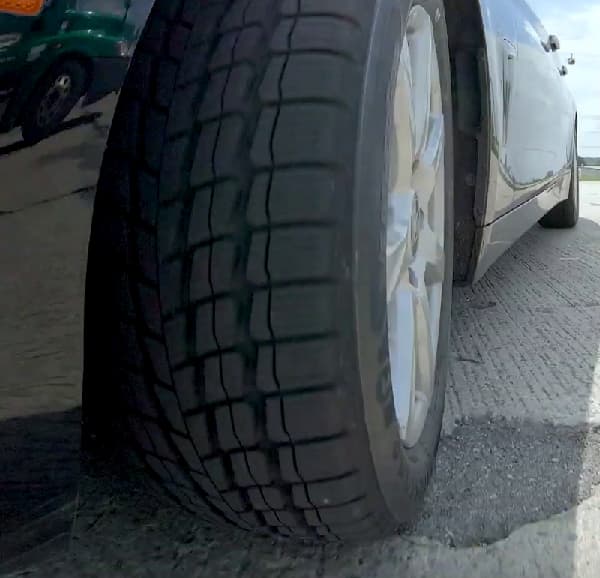
However, we also need to look at the WeatherGrip from the perspective of other grand-touring all-season tires.
Those that feature milder tread patterns, like the Bridgestone Turanza QuietTrack, will run circles around Firestone’s competitor in overall grip and traction.
And even in the same all-weather category, the Michelin CrossClimate 2 drives much better, with higher grip and traction.
Still, the WeatherGrip is more than good enough for daily driving. It’s still better than most all-weather tires on dry roads and has ample grip and traction for safe driving at legal speeds.
2. Handling and Steering Feel
Winter tires usually struggle with responsiveness and steering feel, largely because of the softer and more pliable compound but also because the contact patch with the road is smaller.
Since the WeatherGrip resembles a winter tire with its tread pattern, it isn’t particularly quick to react to the driver’s input, nor the steering feels linear. The on-center feel is also not ideal, as the tire doesn’t pass naturally from going straight to turning.
Fortunately, the straight-line tracking is excellent, which is frankly the most important thing for most drivers of passenger cars.
3. Wet Grip, Traction, and Braking
Firestone utilized its Hydro-Grip Technology Package, which utilizes a rounded footprint that cuts through standing water, along with full-depth grooves and open shoulder slots to evacuate water out from the tread.
As a result, the hydroplaning resistance is outstanding – your car won’t lose stability even when you drive through deep puddles of water.
However, rain traction isn’t always about hydroplaning resistance – the tread compound also needs to do a good job of sticking to the wet pavement.
And in this case, according to our wet road test, the WeatherGrip performs admirably; the longitudinal traction is good, and the tire feels surefooted during cornering.
One area where it struggles is braking – the stopping distances are longer than its main competitors.
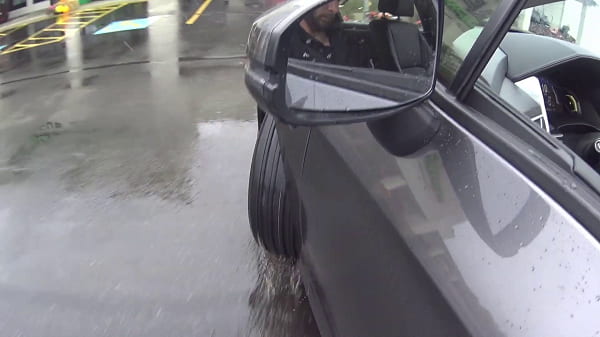
Overall, most premium all-season tires perform better than the WeatherGrip in rainy conditions, and even some all-weather tires, like the General Altimax 365 AW.
Still, in my eyes, at least, the traction and grip are more than good enough for daily driving, again, just like in dry conditions.
4. Is it Good for Winter?
We finally came to the category where the WeatherGrip says it brings the bigger improvement over other all-season and all-weather tires.
Firestone utilized its Snow Traction Claw technology on the center and shoulder ribs for added traction in snow.
The brand’s engineers also added snow vices and high-density zigzag sipes to further enhance the traction on snow.
Lastly, the TractionTech Package creates more edges, helping the tire retain the snow and ice traction throughout its life.
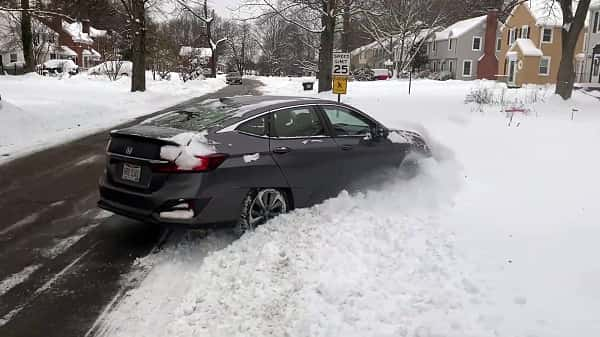
With our snow road test, the WeatherGrip is an excellent tire for wintry conditions.
It provides good longitudinal traction, meaning it brakes and accelerates without too much fuss, and it turns well into a corner.
This is most true for packed snow, but that’s okay since you won’t encounter unpacked snow on public roads. What impressed me the most is that the tire provides good ice traction, something that you won’t see in many other all-season tires.
However, while the Firestone WeatherGrip is very good on snow and ice, a winter tire will be even better. Hence, if you live in areas with very harsh wintry conditions, you should go for proper winter tires.
Comfort and Road Noise
Firestone says it focused on delivering a comfortable ride with the WeatherGrip, and it succeeded.
The tire rides smoothly over most roads and doesn’t transmit vibrations or harshness inside the cabin. There is some shudder when you hit larger potholes, though.
The noise characteristics of the WeatherGrip aren’t favorable – I could easily hear the tires on the highway, more so than with other all-season tires.
You can see more Firestone Weathergrip review here: Video created by Everyday Cars
Should I Buy the Firestone Weathergrip?
The Firestone WeatherGrip is not a perfect tire, but then again, most tires aren’t.
Namely, Firestone sacrificed a bit of dry and wet traction to provide better performance on snow, so if you don’t live in areas with harsh wintry conditions, this is not the tire for you.
However, if you do encounter snowy and icy roads in your area, the WeatherGrip is an excellent tire. It still provides safe dry and wet traction for daily driving while bringing the snow and ice traction much closer to a winter tire.
Thus, I think you should definitely put it on your shortlist!
List of the Firestone Tires Review
I’m Ivo Gievski, the content writer for Tireer. We built our website with over 15 years of experience and extensive research in the automotive and technology sectors. My dedication to delivering high-quality content is unwavering, and I strive to continuously hone my skills to stay ahead of industry trends and provide readers with informative, engaging, and valuable insights.
What’s your opinion on the Michelin Primacy MXM4? Trying to decide between this one and Michelin Primacy MXM4. Bridgestone Driveguard excels in overall wet and snow ratings, by contrast, Primacy MXM4 garnered higher points when it came to overall dry, comfort, noise, and wear ratings.